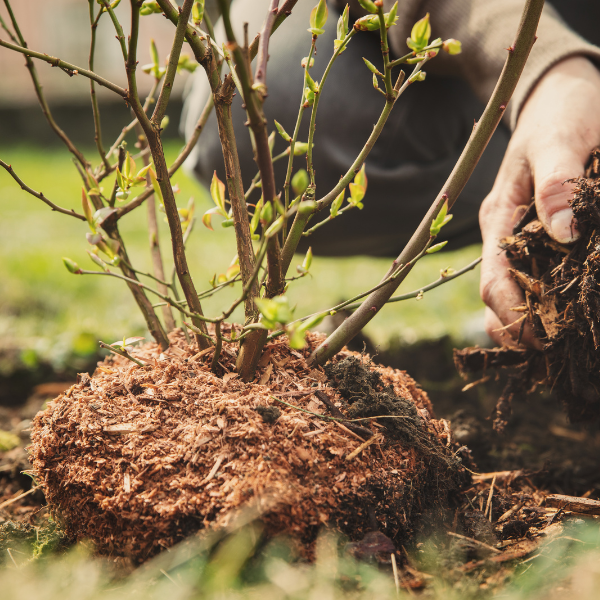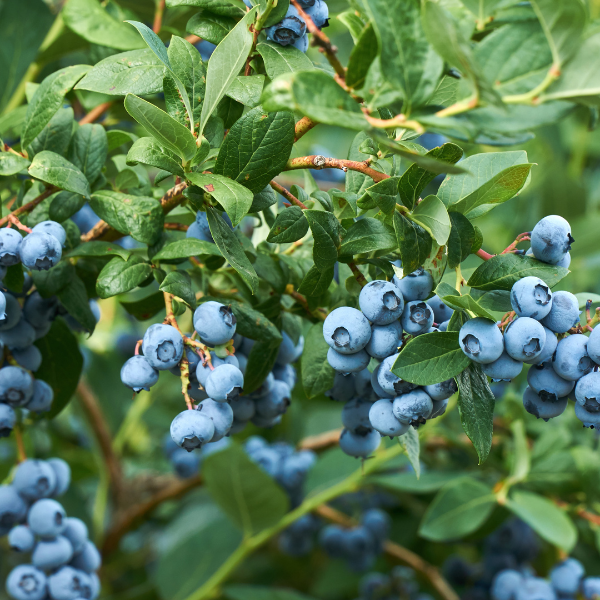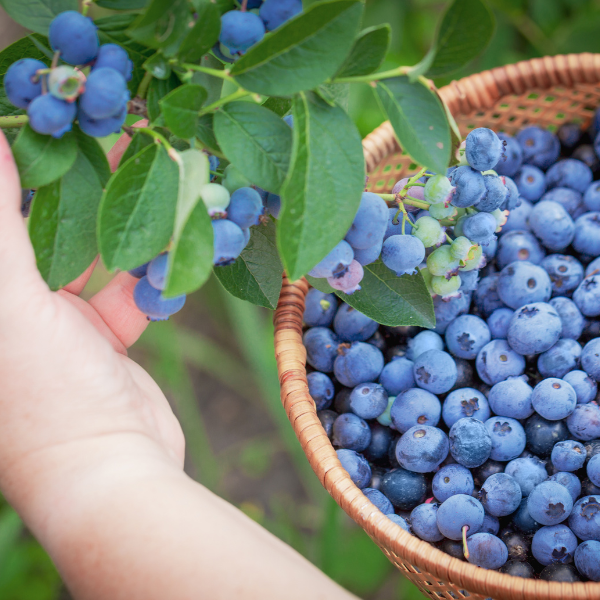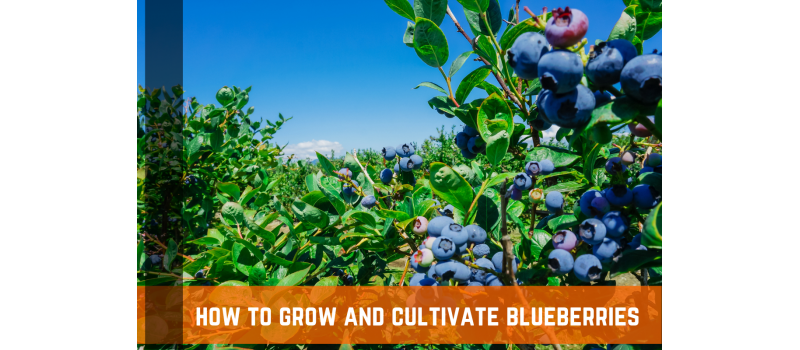Blueberries are more than a simple and delicious snack. They include a lot of minerals, antioxidants, fiber, and vitamins. Blueberries, fortunately, are simple to grow with minimal effort — if you have the correct soil conditions. Learn how to grow blueberries, care for, prune, and harvest your blueberry plants in our Blueberry Growing Guide.
Blueberry bushes, a cousin of rhododendron and azalea, are not only a fantastic fruiting plant but also an appealing addition to your overall landscape, with crimson autumn leaves and white, bell-shaped spring blooms. Read on to learn why you should cultivate blueberries in your backyard.
Types Of Blueberries
Blueberry plants are classified into four different types: highbush, lowbush, half-high, and rabbit eye. They are largely classed by size, and blueberry plant breeders are always developing new types to boost their yields. Among the most common are:
Southern Highbush
Southern highbush is regarded rather difficult to cultivate, although numerous cultivars, including 'Emerald' and 'Windsor' are popular in gardens. These are shorter shrubs that grow three to six feet tall and spread four to five feet wide. They can be cultivated in zones 7 to 10.
Highbush
Highbush blueberries are the ones often seen in supermarkets. They belong to the Vaccinium genus, which also includes lowbush blueberries, cranberries, huckleberries, and lingonberries. The highbush blueberry is common to North America's eastern coast.
Vaccinium species, like azaleas, mountain laurels, and rhododendrons, are members of the Ericaceae family. Highbush blueberries, like other heather family plants, are acid-loving plants that have evolved to thrive in low-fertility settings such as bogs and heaths.
Lowbush
Lowbush Blueberries are cold-tolerant shrubs that may be grown as far north as zone three. They develop substantially differently than other varieties, reaching a height of approximately one foot and spreading in a crawling manner.
The berries, which are native to the northeast United States and southern Canada, have a waxy coating that gives the fruit a gray appearance. These are commonly referred to as wild blueberries.
Half-high Blueberries
Half-high blueberry bushes are a hybrid between highbush cultivars that produce large berries and cold-tolerant wild lowbush species. Half-high blueberry bushes are hardy in USDA zones 3-5 and are less prone to winter damage than highbush plants.
Cultivating half-high blueberry cultivars provides gardeners with an alternative to the little wild berries of the lowbush variety in zone 3, where highbush plants would not flourish. The hybrid half-high blueberry develops at an intermediate height of 2 to 4 feet. Half-high blueberry bushes are simple to manage and keep the berries within reach for convenient picking due to their compact size.
Rabbiteye
Rabbiteye blueberries were originally classified as Vaccinium virgatum. It is mostly cultivated in the southern United States. They may reach a height of 15 feet and need two or more types to pollinate well. 'Powderblue,' 'Woodard,' and 'Brightwell' are all recommended types. Rabbiteye blueberries are excellent alternatives for gardens in zones 7–9.

How To Grow Blueberries
Choose a location with adequate air circulation and full daylight for at least eight hours every day. Blueberries may withstand soil pH levels ranging from 3.8 to 5.5, but prefer soil pH levels closer to 4.5. It is recommended that all gardeners test their soil yearly and base fertilization and pH changes on testing results.
Select and prepare a planting location for spring planting in the autumn to give time for pH correction, if required. Weeds should be controlled before planting to avoid competition with blueberry plants. After planting blueberry plants, apply 3 to 5 inches of mulch around each plant to aid with water retention and weed development.
When To Plant
Blueberry bushes should be purchased as bare-root plants that are two to three years old. Older plants are more susceptible to transplant shock and will require many years to produce substantial yields. Blueberry bushes are typically planted between early and mid-spring. They may also be planted in late autumn in USDA Hardiness Zones 6 and above. Keep any dogs or pets away from newly planted trees or flowers.
Select A Site
Choose a location that gets full sun yet is protected from high winds. Avoid growing near tall trees or plants that may obscure sunlight or compete for soil moisture and nutrients. Ascertain that the planting area has adequate soil drainage. Blueberries may also be grown in pots provided they get enough sunshine and moisture.
Planting - Spacing & Depth
Blueberry bushes should be planted in rows four to five feet apart, with adjacent rows nine to ten feet apart to provide for enough harvesting area. Spread the roots of plants into a prepared hole, then cover them with dirt, making sure the root ball is no more than 1/2 inch below the soil surface. Plant container-grown blueberries at the same depth they were in the nursery pot.

Blueberry Plant Care & Maintenance
There are just a few additional care problems to consider as your blueberry bushes mature, apart from monitoring moisture levels on a regular basis and keeping a healthy layer of mulch.
Pruning
Blueberry bushes should be pruned when they are dormant, before leaf buds emerge on the stems. Remove any branches that are crossing, arching toward the ground, or blocking off too much light from the bush's center while in leaf.
The productive lifespan of blueberry bush stems is short. Stems that are at least 6 years old will yield less and fewer berries with time. Meanwhile, the bush will continue to sprout new branches from the plant's base. Pruning off these older stems to create space for new shoots will result in healthier plants and more abundant yields.
Nutrients
Blueberries should not be fertilized in their first year. After a year, you may begin feeding your blueberries based on two primary indicators: when the flower buds first open, and again when berries begin to develop. Remove weeds on a regular basis to prevent weeds from consuming soil nutrients instead of your blueberry plants.
Ammonium sulfate is often employed as a blueberry fertilizer. For acid-loving plants, you may use any fertilizer, including blueberry and azalea food. Gardeners may apply foliar sprays or fertilize the soil, with many opting for organic fertilizers such as fish emulsion, compost, or manure.
Harvesting Blueberries
Blueberries are usually available to pick between June and August. Most blueberry bushes will begin to produce a little crop by their third year, but will not completely mature until their sixth year. Mature blueberry plants produce around eight quarts of berries per bush.
The only sure method to tell whether blueberries are ripe to pluck is to taste them. Blueberries are tastiest when left on the plant for at least a week after turning blue. Ripe blueberries will easily detach from the stem. As soon as possible, place them in the refrigerator unwashed. When refrigerated, they may last up to a week. Be sure to wash them right before eating.

Blueberry Pests & Diseases
To deter birds and deer from eating berries, use netting or wire cages. Foliar disease may be reduced by planting in a good site with enough spacing and yearly trimming to allow for air circulation. Blueberry plants will be less vulnerable to illnesses overall if resistant types are chosen and optimal circumstances for a healthy plant are provided.
However, certain diseases, such as mummy berry, anthracnose, Phomopsis, and Fusicoccum canker, may emerge over time and need the use of fungicidal medicines. Sanitation and removal of diseased berries from the plant and ground, together with the use of Actinovate or Double Nickel, should lessen the severity of mummy berry and anthracnose. Keep any dogs or pets away from your blueberry plant.
Phomopsis and Fusicoccum canker can be reduced by carefully trimming stems with canker and applying copper. Choosing places with well-drained soil and avoiding clay can help prevent root rot infections. When roots are moist, bedding is reused, or new plants are put in an area where berries have previously been grown, root rots such as Phytophthora root rot are widespread.
Aphids, leafhoppers, Japanese beetles, borers, and maggots are among the insect pests that may harm blueberries. Spinosad is an ecologically approved insecticide, however it is also toxic to pollinators like bees. It should only be used when the plant is not in bloom.

